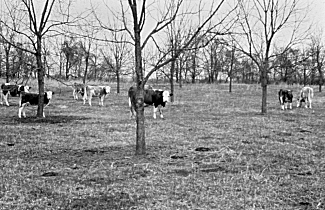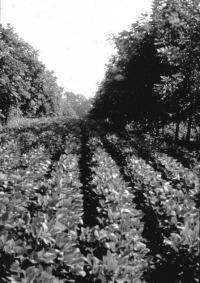
|
| Walnuts grown for "commercial timber production" may qualify for a tax deduction under Section 194 of the Internal Revenue Code (IRC). |
Agroforestry is a mix of disciplines including forestry, agriculture and horticulture. Accordingly, agroforestry tax advantages also can be derived from forestry, agriculture, and conservation, as well as from small business tax laws.
According to the Internal Revenue Service (IRS), a farm business is defined as ". . . the trade or business of cultivating land or raising or harvesting any agricultural or horticultural commodity. This includes. . . raising or harvesting of trees bearing fruits, nuts, or other crops. . . " (Instructions for Schedule J, Year 2000, Farm Income Averaging).

|
| Under Section 179 of the IRC, taxpayer must have an active trade or business enterprise from the agroforestry practice, whether it be crops, livestock, timber, nuts or some other product, in order to qualify for this exemption. |
However, for certain situations, the IRS specifically says "you are not farming if you are engaged only in forestry or the growing of timber" (Publication 225; Farmer's Tax Guide). This seems to complicate the position of the taxpayer who uses agroforestry practices. However, because agroforestry consists of both raising trees and agricultural commodities, tax advantages can come from both the forestry and the farming incentives.
There are five possible tax incentives for landowners who choose to plant trees in an agroforestry practice. These incentives are described in Section 48, Section 126, Section194, Section 179, and Section 175 of the Internal Revenue Code (IRC). Section 126 allows an exclusion of cost-share and other payments that are available through certain specified programs. Some of these specific programs, such as the Wildlife Habitat Incentive Program (WHIP), provide incentives to the landowner who incorporates trees into land-use plans for the purpose of improving either wildlife or conservation benefits. It is important to work with natural resource professionals to identify excludable cost-share programs that are currently funded and support agroforestry practices.
Sections 48 and 194 provide incentives for the landowner who plants trees into the agricultural landscape. They are the reforestation investment tax credit (Section 48) and the reforestation amortization deduction (Section 194). These two incentives can provide a substantial tax reduction if trees are planted in an agroforestry practice for "commercial timber production" - any other intent will not qualify for these incentives. Excluded, for example, are ornamental trees, Christmas trees, fruit trees or trees planted for nut production. The IRC does not specify a planting density or stipulate an acceptable species list. Therefore, the taxpayer's planting intent will most likely be the determining factor as to whether or not the practice qualifies for Section 48 and Section 194 incentives.
Under Section 179, a deduction of up to $20,000 can be taken in a given year to recover the cost of personal property used in an active trade or business. Farm fences, livestock, machinery and equipment, and structures specifically used for the growing of mushrooms or commercial plants qualify for this deduction. The maximum deduction amount of $20,000 will continue to increase over the next three years until it reaches a $25,000 deduction limit in 2003. The key to this deduction is that the taxpayer must have an active trade or business enterprise from the agroforestry practice, whether it be crops, livestock, timber, nuts or some other product.
Finally, expenses for the establishment of windbreaks that are designed based on USDA/NRCS-approved plans are deductible up to 25 percent of gross farm income. Section 175 of the IRC specifically identifies planting windbreaks and the eradication of brush as deductible soil and water conservation expenses.
Income exclusions, tax deductions, and tax credits can provide financial incentives above and beyond the expected revenues from agroforestry practices. The key to tax benefits is good record keeping. Most university extension services have publications describing the best method of record keeping for both timber production and agricultural production. One publication specific to agroforestry is the Economic Budgeting for Agroforestry Practices available from the University of Missouri Center for Agroforestry. Several agroforestry taxation issues are forthcoming in the Center's Agroforestry in Action series. The first publication in this series, Tax Considerations for The Establishment of Agroforestry Practices, is now available.
For more information about this publication or other agroforestry tax questions, contact the University of Missouri Center for Agroforestry by e-mailing to umca@missouri.edu; by calling (573) 884-2874; or by writing to 203 Anheuser-Busch Natural Resources Bldg., University of Missouri, Columbia, MO 65211.
- Larry D. Godsey, economist, University of Missouri Center for Agroforestry.